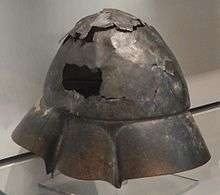Boeotian helmet

The Boeotian helmet was a type of helmet that was used in Classical Antiquity and the Hellenistic period; it possibly originated in the Greek region of Boeotia.
Characteristics


The Boeotian helmet was an open helmet, allowing good peripheral vision and unimpaired hearing. It had a domed skull surrounded by a wide, flaring, down-sloping brim. The brim came down at the rear to protect the back of the neck, projected forward over the forehead and was worked into a complex shape at the sides, with downward pointing folds affording some lateral protection to the face. A long falling plume was sometimes attached to this type of helmet. The need for unimpeded vision and good hearing was particularly acute for cavalrymen, therefore this type of helmet was used primarily by mounted troops.[1] It was modelled on the shape of a folded-down Boeotian variant of the petasos, a type of Greek sun hat, usually made of felt.[2]
This type of helmet was beaten from a single sheet of bronze using a helmet-shaped "former," one of which, made of limestone, is extant. An excellently preserved example of this type of helmet, now in the Ashmolean Museum, was recovered from the Tigris River in Iraq. It may have belonged to one of Alexander the Great's cavalrymen. In Late Hellenistic times the Boeotian helmet evolved into a type with a taller, more conical skull and often a reduced brim.[3]
Use
The Athenian military expert and author Xenophon particularly recommended the Boeotian helmet for cavalry, saying "...the Boeotian type [of helmet]. For this not only gives the greatest protection to all the parts above the cuirass, but allows free vision." This piece of advice was taken up by Alexander the Great, who equipped his cavalry with this helmet.[4] Both the Alexander sarcophagus and Alexander mosaic show cavalrymen of the Ancient Macedonian army wearing Boeotian helmets.[5] As a specialised cavalry helmet its use was not as widespread as some other ancient helmets, such as the Corinthian or Phrygian types. The helmet was used by Roman citizen cavalry in the Republican period. On the Altar of Domitius Ahenobarbus, Gnaeus Domitius Ahenobarbus was consul in 122 BC, a Roman cavalryman is depicted wearing one (with the later more conical skull and furnished with a falling horsehair plume).
The naming conventions and typology of ancient helmets are largely of modern origin and do not reflect contemporary usage; "Terms such as 'Illyrian' and 'Attic' are used in archaeology for convenience to denote a particular type of helmet and do not imply its origin."[6] The term 'Boeotian helmet', however, is an exception: it was employed by Xenophon and is therefore of contemporary usage. Another piece of martial equipment linked to the region of Boeotia is the Boeotian shield; however, no surviving examples have been found, and its association with the region is largely through depictions on local coinage.
References
Bibliography
- Anderson, J.K, (1961) Ancient Greek Horsemanship, Berkeley and Los Angeles.
- Connolly, P. (1981) Greece and Rome at War. Macdonald Phoebus, London. ISBN 1-85367-303-X
- Sekunda, N. (2002) Marathon 490 BC: The First Persian Invasion Of Greece. Osprey Publishing.
| Wikimedia Commons has media related to Category:Ancient Greek helmets. |